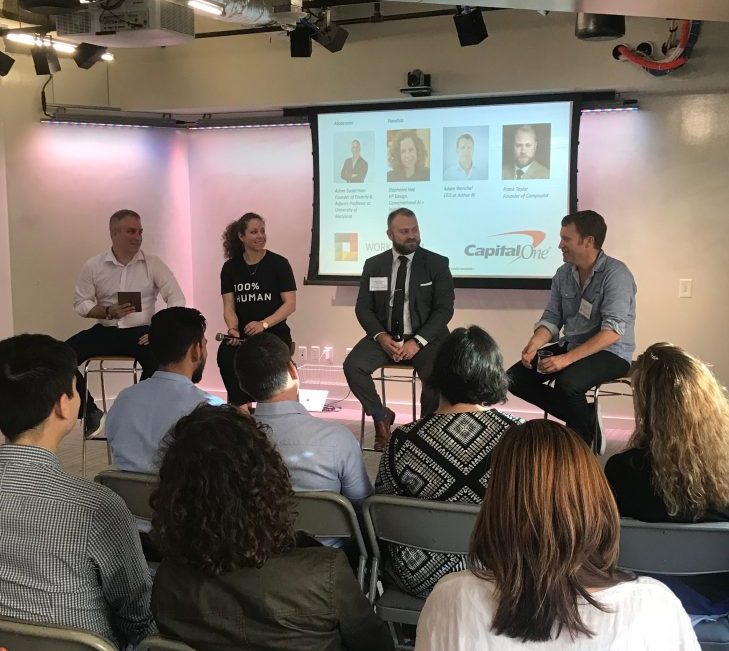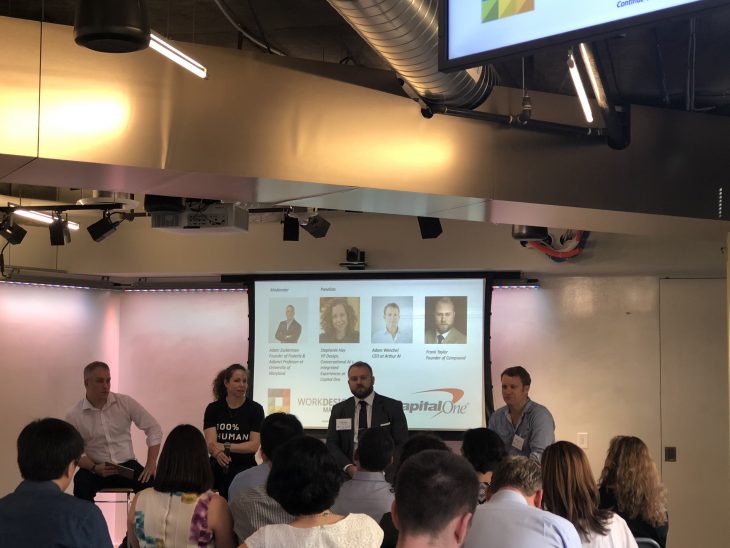Didn’t get the chance to make it to our most recent TALK? Check out our recap to learn more about how machine learning and AI are manifesting in today’s workplace!

Partnering with Capital One, WDM’s latest event was held for our Washington, D.C metro area readers at the Capital One Lab in Clarendon, VA. We were fortunate to book a slate of panelists who were able to share with our audience, several views of how Machine Learning and Artificial Intelligence manifests in today’s digital environment.
New technologies are redefining what work is and help us manage our work, wherever that may be. Our panelists are managing the use of these technologies in their daily work and it was most interesting to hear their differing opinions and interactions with these tools.
Our panel included Adam Zuckerman, Founder of Fosterly and Adjunct Professor at the University of Maryland, Stephanie Hay, Vice-President Design; Conversational AI + Integrated Experience at Capital One; Frank Taylor, Founder of Compound Technologies, Inc.; Adam Wenchel, CEO at Arthur AI.
Adam Zuckerman got the conversation started by stating that most people may not even notice when they are using an AI or Machine learning tool. Stephanie followed by explaining that applying machine learning tools helps her team at Capital One understand how their employees work and how their work affects them. Frank’s company is exploring opportunities to deploy machine learning as the size of their data set and complexity of operations grow. Adam Wenchel brought up that there is also a need to understand where AI can go wrong, and that the technology requires ongoing development.
Perhaps the simplest use and what is most comprehended is how AI can help companies figure out what their customers want and need by analyzing data. Stephanie elaborated on this commenting on how the AI and ML tools can be utilized to work with point of sale security to creating progressive conversations that expand their time and channels when interacting with the customer during a transaction. This leads to providing automated statistics as part of their research, again helping determine what customers or clients want and need. However, there is still a need to humanize machine intelligence.
Frank pointed out that there are some critical differences in the types of AI. The kind of information gathered and disseminated through their tool is utilized by a distributed workforce, the tool(s) can organize who is where. Other options for the tool have the capability to determine maintenance requirements or schedule and organize physical changes in a building. Of course, this is all dependent on how the humans program the machines! The data is required to document the resources, but the human talent is needed to develop the program models.
Collectively the panel addressed the pain points as this technology becomes more advanced. Privacy issues are clearly one of the main points of concern. The increasing use of cameras and facial recognition while providing critical information can also be problematical. Regulatory oversight is a hot topic globally.
Our moderator Adam Zuckerman opened up the floor to questions starting by asking the audience what forms of AI technology they were seeing and using in their daily lives. One audience member described how his architecture firm is using AI to look at density of residential units to be able to automate the process so that they are able to find efficiencies.
Another chimed in about a comment made earlier in the panel about monitoring where people and desks are located in the workplace. Beacon technology is frequently used in the workplace today to monitor things like room usage, but there’s been pushback on this type of technology from people who feel it has a “Big Brother” effect. The audience member was curious how the panelists thought you should communicate to your team that this technology is not being used to watch you 24-7 and will benefit their work.
Stephanie shared advice that an executive told her: we all carry phones and on the day that you start a new job, you typically agree that your data and anything you create there is the company’s work product. Only through the ambiguity of our systems and lack of intelligence, have people been able to enjoy the privacy that comes along with it. Only until things like email and other forms of machine learning, did people start having to wrestle with what was already there. Being transparent about the intention in the first place is the answer.
Adam Zuckerman added that when you are grocery shopping, they are often tracking your phone via wifi to learn your flow of the supermarket. You have no concept of what’s going on, but it’s happening. Would you stop shopping at that store if they put up a notice that stated they were tracking you, but you were going to get better service for it?
Our publisher, Bob Fox, then pointed out that in order for technology to provide a high level of service, we have to give up more information about ourselves and what we’re trying to do. Many people don’t understand this and it creates a challenge in policy and setting the bar for how we apply it.
An audience member noted that you can use your thumb print to login to your online banking accounts, including Capital One. What’s more personal than handing over your thumb print? Stephanie added that they also have your money as well!




